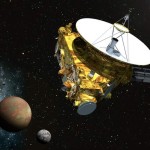Glaciers
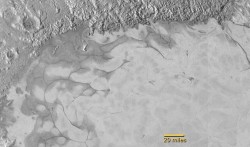 NASA releases a photo which suggests that glaciers are flowing on Pluto’s surface in the region of Sputnik Planum. Scientists believe the ice is made of nitrogen, carbon monoxide and methane.
NASA releases a photo which suggests that glaciers are flowing on Pluto’s surface in the region of Sputnik Planum. Scientists believe the ice is made of nitrogen, carbon monoxide and methane.
To see evidence of recent geological activity is simply a dream come true. The appearance of this terrain, the utter lack of impact craters on Sputnik Planum, tells us that this is really a young unit.
Heart shape sharper image
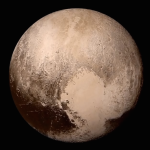 NASA releases a sharper image of Pluto showing that the left half of the Tombaugh Regio heart region is different than the right. The left half is more filled in. Scientists believe some process, possibly wind, is blowing material from the left half to the right half.
NASA releases a sharper image of Pluto showing that the left half of the Tombaugh Regio heart region is different than the right. The left half is more filled in. Scientists believe some process, possibly wind, is blowing material from the left half to the right half.
Our interpretation is that material in the right lobe — the source for that material — is coming from the western [or left] lobe.
NASA anticipates greater discoveries
Speaking before the House Committee on Science, Space and Technology, Stern says scientific information gleaned from the New Horizons mission to Pluto is “revolutionizing” what they know about the icy dwarf planet, predicting that even greater discoveries lay ahead.
With only 5% of data on the ground, we all feel we need to fasten our seat belts for the next 95%.
It will take 16 months for all the collected data from New Horizons to be transmitted to Earth. Scientists say the mission demonstrates this need for further planetary exploration.
Now is the time to accelerate, not curtail, the pace and scope of our nation’s solar system exploration program.
Next flyby target selected
NASA determines the next likely target destination for a flyby by New Horizons, a small object in the Kuiper Belt called 2014MU69. It orbits almost a billion miles away from Pluto. A full proposal about the mission will be evaluated by NASA experts before the go ahead is officially given. NASA Science Mission Directorate Chief Grunsfeld:
Even as the New Horizon’s spacecraft speeds away from Pluto out into the Kuiper Belt, and the data from the exciting encounter with this new world is being streamed back to Earth, we are looking outward to the next destination for this intrepid explorer. While discussions whether to approve this extended mission will take place in the larger context of the planetary science portfolio, we expect it to be much less expensive than the prime mission while still providing new and exciting science.
Pluto hi-resolution images
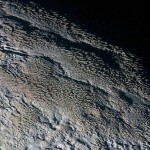 NASA releases high resolution New Horizons images of Pluto’s surface that show rippling terrain that stretches many hundreds of km. Team member:
NASA releases high resolution New Horizons images of Pluto’s surface that show rippling terrain that stretches many hundreds of km. Team member:
It looks more like tree bark or dragon scales than geology. This’ll really take time to figure out; maybe it’s some combination of internal tectonic forces and ice sublimation driven by Pluto’s faint sunlight.
The ripples are part of a 70MB image (link) that combines images from the probe’s Ralph/Multispectral Visual Imaging Camera, that combines blue, red and near infrared (NIR) images.
Tens of millions of Pluto pixels, in color. The highest-res enhanced-color view of Pluto yet. http://t.co/jSZ2Fqyo6q pic.twitter.com/VJUsoZwMlM
— Dr. Alex Parker (@Alex_Parker) September 24, 2015
Charon detailed images
NASA releases detailed photos and a flyover animation of Charon, taken by New Horizons when it made its close flyby of Pluto on July 14. Scientists say they expected to find a long-dead world pocked with craters, but instead the surface plays host to mountains, a red north pole and a host of other geological features including a canyon more than 1,000 miles wide that stretches across the moon’s Pluto-facing side, and perhaps along the far-side of the world. That canyon is probably four times longer than the Grand Canyon is on Earth, and twice as deep in some places.
We thought the probability of seeing such interesting features on this satellite of a world at the far edge of our solar system was low, but [we] couldn’t be more delighted with what we see.
Water and ice found
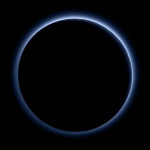 NASA says that Pluto has traces of water and ice on its surface. Red-colored frozen surface water is confirmed by combining spectral infrared and visible light data taken by two of New Horizons’ image sensors. The agency also releases a picture of Pluto’s blue sky, which is caused by tiny, sunlight-scattering particles in the atmosphere. Those particles probably begin as molecular nitrogen (which Pluto is constantly emitting) and other trace gases.
NASA says that Pluto has traces of water and ice on its surface. Red-colored frozen surface water is confirmed by combining spectral infrared and visible light data taken by two of New Horizons’ image sensors. The agency also releases a picture of Pluto’s blue sky, which is caused by tiny, sunlight-scattering particles in the atmosphere. Those particles probably begin as molecular nitrogen (which Pluto is constantly emitting) and other trace gases.
